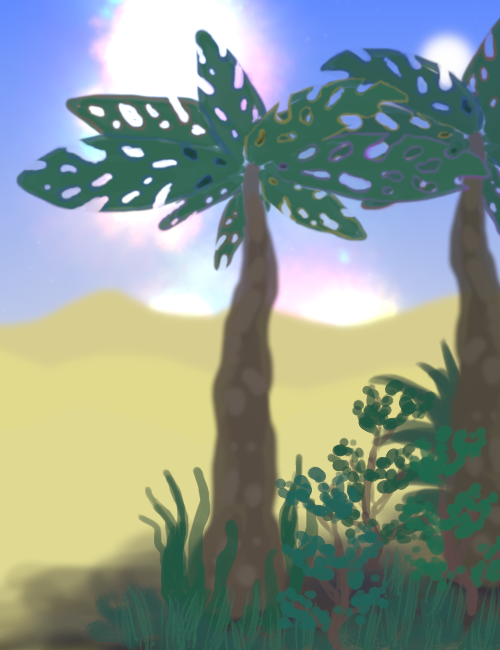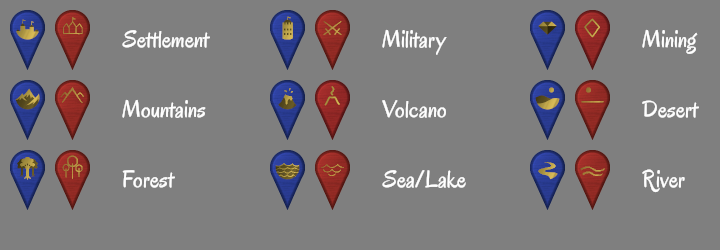Ligytara
The most common tree in the Vélyphola Desert.
Basic Information
Anatomy
The palm trees have long trunks which are thick and sturdy near the ground but highly flexible near the top.
Their leaves are large and flat but riddled with holes of various sizes and shapes. They fan out into shallow but wide treetops.
Biological Traits
The base color of the leaves is a dark, bluish green. However, their outer edges and those of the holes tend to be lined with different colors. These are usually the same per leaf, but not necessarily per plant.
Genetics and Reproduction
Ligytarané form clusters of small nuts below the leaves. A single nut is approximately 1 cm wide and 3 cm long. As they ripen, the outer shells rip open and a spring unfurls to lauch the seeds far away from the parent plant.
Growth Rate & Stages
These plants grow impressively fast, especially in the summer months. They can gain up to 35 cm per day when the light is most intense. Young shoots start out with a smooth stem which takes on a lumpy, sickly appearance as the wood grows thicker in irregular patterns.
Biological Cycle
Adult plants die off completely during winter, to be replaced by those which start germinating and taking root around early spring. This causes the forests in the Vélyphola Desert to change drastically each year as the new trees rise up in unpredictable positions and quantities. The phenomenon is known as "wandering forests", or mudanolé in the Nimýric language.
Additional Information
Domestication
Ligytarané are often intentionally planted in oasis settlements. Their inhabitants wrap elegantly decorated fabrics around the nut clusters when they are nearly ripe so that they can be collected more easily for the next year.
Uses, Products & Exploitation
The trees themselves can be used for wood. Their nuts are mildly toxic and have little nutritional value, but they are useful for medicine. For example, small doses are able to lower fever and treat certain forms of headache.
Geographic Origin and Distribution
These trees are only known to grow in the Vélyphola Desert, near the equator of eastern Gysuphun.
Symbiotic and Parasitic organisms
The large crowns provide shadow which allows less resiliant plants to endure the hot climate in this area. A ligytara is often surrounded by a small biotope of various shrubs, herbs and grasses. In larger forests these can merge into a dense undergrowth which retains morning dew or rainwater for a few hours.
Many smaller animals also seek refuge under their leaves. Of note is the phópseó, a bird which uses twigs and grass blades from the secondary plants to weave basket-like nests below the treetops.





I like the sketch. And honestly, I am envious. (I can't draw to save my life! Thank goodness for HeroForge and Pixabay.)
Thank you, I'm glad you like it! ^^
Creator of the Kaleidoscope System and the planet Miragia.